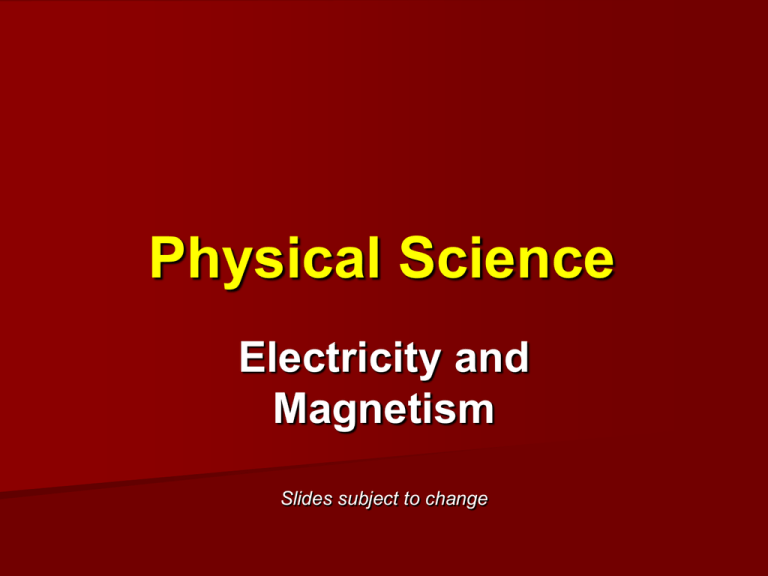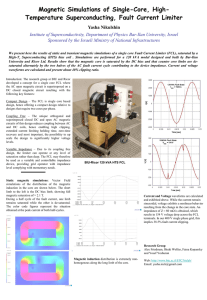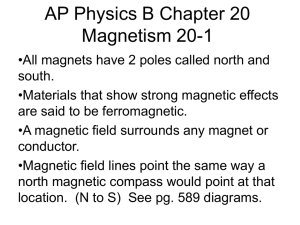Electricity
advertisement

Physical Science Electricity and Magnetism Slides subject to change Electric Charge Charge is a fundamental quantity (just as mass is a fundamental quantity). Positive and negative charges. Charge is measured in coulombs (C). Elementary charge e = 1.6x10–19 coulombs. At atomic level protons +e electrons −e neutron no charge Atomic Level Most atoms have equal number of electrons and protons. Hydrogen 1 proton, 1 electron Uranium 92 protons, 92 electrons If unbalanced number of charges, atom is called an “ion.” Sodium ion, one less electron than usual Na+ Chlorine ion, one more electron than usual Cl– Forms sodium chloride, “salt” Exercise If an object has 1 million more electrons than protons. What is the net charge? Given Formula N = 1x106 excess electrons q = Ne e = charge per electron = –1.6x10–19 C q = Ne = (1x106)(–1.6x10–19) = –1.6x10–13 C Static Electricity Excess charge. zzzzzt; crackle! Benjamin Franklin In 1750 Franklin proposed an experiment to prove that lightning is electricity—fly a kite in a storm that appeared capable of becoming a lightning storm. May 10, 1752 Thomas-François Dalibard of France conducted Franklin's experiment using a 40-foot-tall iron rod instead of a kite, and he extracted electrical sparks from a cloud. Physics Backfires Prof. Georg Wilhelm Richmann electrocuted July 26, 1753, following Franklin's experiment. Electrocuted in St. Petersburg, Russia, while "trying to quantify the response of an insulated rod to a nearby storm." Current When charge “q” flows, we have current “I” measured in amperes (A): I = q/t Current is the rate of flow of electric charge (units are coulombs/second or amperes). Metal is good electrical conductor, other materials such as glass are poor conductors (called “insulators”). Exercise If 0.16 coulombs of charge are released across a wire in 0.10 s, what is the current? Given Formula q = 0.16 C I = q/t t = 0.1 s I = q/t = (0.16) / (0.10) = 1.6 ampere Coulomb’s Law Force between charges: F = k q1q2 r2 k = 9.0x109 N-m2/C2 Electric force is proportional to the charges on the objects and inversely proportional to the square of the distance between them. Voltage Amount of work it takes to move a charge of 1 coulomb between two points. Measured in volts (V). A battery supplies this work by electrochemical action. 1.5 V 9V 12 V Schematic Resistance Opposes current flow. Metals offer little resistance, insulators great resistance, semi-conductors moderate resistance. Units are called ohms (Ω). Schematic Ohm’s Law Voltage V equals the current times the resistance. V = IR I V R Ohm’s Law Voltage V equals current I times resistance R: Given R = 3.0 ohms. V = 12.6 volts V = IR = 12.6 = I (3.0) I = 4.2 amps Formula V = IR I R=3.0 Ω V Add a Switch I=0 “Open circuit” if switch is open – no current flows. “Closed circuit” if switch closed, current flows. V R Car Headlights A typical car alternator generates up to 60 amps at 14 volts. “Open circuit” if switch is open – no current. “Closed circuit” if switch closed, current flows. V Power Power P equals current I times the voltage V: P = IV Joule’s Law Electrical power units same as with mechanical energy, watts (W). Car headlight (halogen) I = 4.2 A, V = 13 V. P = IV = (13)(4.2) P = 55 W Light Bulb Original commercial bulb: carbonized filament. Today: tungsten filament in an inert gas. Thomas Edison – in his lab in 1880 tested over 6,000 various carbon filaments before he got a carbonized cotton thread to last 15 hours before burning out. Edison Electric Light Company → GE in 1892. Car Battery Power A typical car battery has voltage of 12.6 V, maximum “cold cranking amps” of 500 A. How much power is available to start your car? P = IV = 500 x 12.6 = 6,300 W Recall 1 hp = 746 W Therefore, P = 8.4 hp “Turns over” the engine. Connect Elements in Series Both lamp elements have same current. Rseries= R1 + R2 What if one light burns out? No current, open circuit! R1 R2 Connect Elements in Series Both lamp elements have same current. Let R1 = 30 Ω R2 = 30 Ω Find equivalent series resistance – Rseries = R1 + R2 = 30 + 30 = 60 Ω R1 R2 Connect Elements in Parallel Both lamp elements have same voltage. 1/Rparallel= 1/R1 + 1/R2 What if one light burns out? No problem! R1 R2 Connect Elements in Parallel Both lamp elements have same voltage. Let R1 = 30 Ω R1 R2 = 30 Ω R2 Find equivalent parallel resistance – 1/Rparallel = 1/R1 + 1/R2 Resistors in parallel = 1/30 + 1/30 have lower equivalent = 1/15 resistance than Therefore, Rparallel = 15 Ω resistors in series. Magnetism North pole, South pole. Like poles repel, unlike poles attract. Always appear as pairs. Invisible magnetic field Source of Magnetism Source of magnetic field − moving electrons, and in some cases, “spinning” electrons. Electric current in a wire creates a magnetic field. Magnetic materials. A few elements, iron, nickel, and cobalt, and their alloys, have a strong magnetic effect. Magnetic Materials Every electron, by its nature of spinning, is a small magnet. Ordinarily, countless electrons in a material are oriented in different directions, leaving no effect. In an iron bar magnet the electrons are aligned in the same direction, so they act cooperatively, creating a net magnetic field. Earth’s Magnetic Field Earth's magnetic field can be modeled as a simple bar magnet. The direction in which a compass points is known as magnetic north. The Earth's North Magnetic Pole is a wandering point on the Earth's surface, with evidence that it flips about every 300,000 years. Drifting at about 35 miles per year. 85.1° N 135.6° W in 2012. 82.7° N 114.4° W in 2005. 81.3° N 110.8° W. in 2001. Declination The direction of magnetic north from true north is called “declination.” Needed to make corrections in navigation. In Los Angeles, magnetic north is about 12° east of true north. N Magnetic north E W S Electromagnetism Michael Faraday (1791–1867) studied the magnetic field around a conductor carrying a direct current Established the basis for the “magnetic field” concept in physics. Moving a magnet through a static loop of wire creates electric current in the wire. Generator Moving wire loop in a static magnetic field also produces an electric current. Generator converts mechanical energy to electrical energy. History of Local Power Pomona College’s first president Cyrus Baldwin helped found San Antonio Light and Power Company in 1891. It was the first generating plant to provide electricity in the Pomona and San Gabriel Valleys, using a waterfall in San Antonio Canyon. Transformers built by George Westinghouse provided for transmission of 10,000 volts from this plant to Pomona. The source of water proved to be undependable, so the project failed to provide the expected results. Hoover Dam Power 8 of 17 turbines Mutual Induction Two insulated coils of wire. Passing a current through one coil, a momentary current is induced in the other coil. Transformer Transformers are passive devices. Transform alternating current from one circuit into another through electromagnetic induction. Number of windings in secondary determines “step up” or “step down” voltage. Vs = (Ns/Np) Vp Ratio of windings Transformer Motors Current in a conducting wire experiences a force from magnetic field. Motor Split-ring commutator changes direction of the current. Transforms electrical energy to mechanical energy. No Motor Suspend, guide, and propel a train using electromagnets. Magnetic levitation (Maglev) trains. 19-mile Shanghai Maglev train 268 mi/hr. Utility-Scale Power Turns a turbine and generator. Utility-Scale Energy Sources Fossil energy − burn fossil fuels, heat water, and create steam, turn turbine. Nuclear – heat water, create steam, turn turbine. Geothermal – steam from deep in Earth (6000 feet – Hawaii), turn turbine. Gas turbine – hot gases direct into turbine. Wind – wind turns turbine. Hydroelectric – water pressure turns turbine. U.S. Sources of Energy US DOE, 2006 Historical View Energy Information Administration / Annual Energy Review 2007 http://www.eia.doe.gov/cneaf/electricity/epa/epa_sum.html Iron and Permanent Magnets Soft iron Very strong magnetic field when an electromagnetic field applied. Iron’s magnetic field disappears after field removed. Hard iron Retains magnetic field, “permanent magnet” Will lose permanent field if heated or struck. Toy Train Transformer Vp = 120 V ac Np = 1,000 windings Ns = 160 windings. Primary coil Secondary coil What is Vs? Vs = (Ns/Np) Vp Vs = (160/1000) 120 = 19 V Fewer windings on secondary side creates a step-down (lower voltage) transformer. Light Bulb Typical 100-watt light bulb V = 120 volts P = 100 watts What is the current? P = IV 100 = I (120) I = 0.83 amperes Analyze Simple Flashlight 1.0 W flashlight bulb, 3.0 V battery. What is current? Joules’ Law: P = IV = 1 = I (3) I = 1.0/3.0 = 0.33 A V V Continue Simple Flashlight What is the bulb resistance? From previous slide, V = 3.0 V, and I = 0.33 A Ohm’s Law: V = IR, 3 = 0.33R, R = 10 Ω V V







